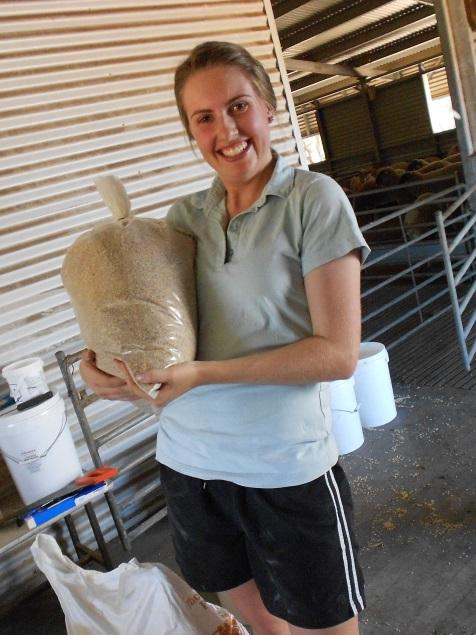Is carb-loading good for reproduction?
Dave Miller, E. Bowen and C. Jacobson, Murdoch University WA, Corresponding author: D.Miller@murdoch.edu.au
Introduction
Breeding from ewe lambs increases reproductive efficiency and speeds up genetic improvement programs by decreasing the generational interval. However, conception rates in ewe lambs can be low. Nutrition is known to affect the reproductive success of ewe lambs, although the precise role of diet is largely unknown.
The mechanism is thought to function through effects on metabolic hormones, such as circulating insulin concentrations. Insulin promotes the secretion of reproductive hormones, known as gonadotrophins, which stimulate ovarian activity and encourage oestrus.
When this pathway was examined in post-calving dairy cattle, high starch diets were associated with a faster return to oestrus, which was thought to be caused by increased circulating insulin concentrations. In contrast, high fat diets were associated with reduced insulin concentrations and decreased conception rates. Dietary starch favours the propionate-producing pathway over acetate in the rumen, increasing insulin, whereas dietary fat reduces insulin synthesis and promotes cellular insulin resistance.
Hypothesis:
↑ Starch (↑ insulin?) → Faster return to oestrus vs. ↑ Fat (↓ insulin?) → ↓ Conception rates
Methods
Two hundred and four Merino x Afrino ewe lambs with an initial live weight (mean ± SEM) of 44.1 ± 0.3 kg were randomly assigned to two dietary treatment groups, one high in starch and the other high in fat (n = 102 per treatment). Rations were fed for a continuous 60-day peri-conception period, (30 days prior to and after joining with the ram).
High Starch = base ration+100g/hd/day lupins+80g/hd/day Megalac
High Fat = base ration+300g/hd/day barley
A base ration of a commercial pellet fed at 700 g/head/day was supplemented to form the two diets. The two diets contained similar levels of crude protein (high starch = 109 g/kg vs high fat = 108 g/kg) and metabolisable energy (high starch = 9.7 MJ/kg vs high fat = 10.1 MJ/kg).
Teaser wethers fitted with marking harnesses were introduced to the ewe lambs at day 0 to detect oestrous activity. On day 17 after the start of the nutritional treatments, the teaser wethers were removed and were replaced with rams fitted with marking harnesses that remained with the ewe lambs for 30 days.
Blood samples were taken from a subset of 20 ewes (per treatment) on days 0, 18 and 60 and analysed for plasma insulin concentration. All ewe lambs were body condition scored and weighed on days 0, 18 and 60 to monitor growth rates. Pregnancy detection on all of the ewe lambs was performed with ultrasonography on days 55 and 85. Body mass and insulin data were analysed by repeated measures ANOVA and fertility data was analysed by chi-square tests.
Results and take home messages
- In contrast to our hypothesis there was no overall effect of nutrition on the circulating concentration of insulin, despite insulin concentrations in the high starch group at day 18 compared to day 0 (Table 1; P<0.005).
- Body mass at joining and pre-joining growth rate did not differ between the diets, however the final body mass of the ewes on the high starch diet was significantly heavier than the group on the high fat diet (Table 1; P<0.001).
| Day | High starch | High fat | SED | P-values (Nutrition) | P-values (Time) | P-values (N x T) | |
|---|---|---|---|---|---|---|---|
| Body mass | 0 | 44.5 | 43.4 | 0.61 | NS | ||
| 18 | 47.4 | 46.4 | 0.64 | NS | |||
| 60 | 50.2 | 47.8 | 0.67 | <0.001 | <0.001 | NS | |
| Insulin | 0 | 0.32 | 0.32 | 0.04 | NS | ||
| 18 | 0.50 | 0.40 | 0.07 | <0.005 | |||
| 60 | 0.41 | 0.32 | 0.05 | NS | <0.005 | NS |
Points to note:
- Diet had no overall effect on circulating insulin
- There was no overall effect of diet on body mass at joining and pre joining growth rate
- Ewes on the high starch had a higher final body mass
Again, in contrast to our hypothesis, higher concentrations of insulin at joining, irrespective of nutritional treatment, had no effect on conception rates. There was also no effect of nutrition on the proportion of ewes displaying oestrous cycles (high starch = 78% vs high fat = 75%) or the number of twin pregnancies (high starch = 10% vs high fat = 5%).
Cycling ewes on the high starch diet had a higher conception rate than the ewes on the high fat diet (high starch = 96% vs high fat = 85%; P<0.05). This response however, was most likely not related to any changes in insulin, but rather the greater gains in body mass of the high starch group (high starch = 101.8 g/head/day vs high fat = 78.6 g/head/day; P<0.001).
Further supporting this, higher body mass at joining, irrespective of nutritional treatment, was associated with increased cycling rates (P<0.01), conception rates (P<0.05) and the twinning rate (P<0.01) (Figure 1).
Points to note:
- Ewes with a higher body mass performed better on all parameters.
- Ewes on the high starch diet had a higher final body mass
Conclusion
In contrast to work in dairy cattle, our findings demonstrate that feeding a high starch diet to increase insulin concentrations and thereby improve ewe lamb fertility was not effective with the level of dietary starch used in this study.
However, the results do emphasise the importance of providing the necessary nutrition to achieve a suitable body mass for ewe lambs pre-joining, in order to maximise conception rates.
Acknowledgments goes to Wellard Agri Ltd for the ewe lambs and facilities and Lienert Australia Pty Ltd for the Megalac®.

